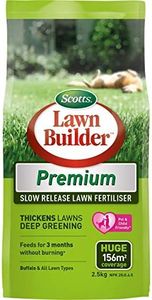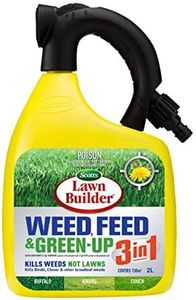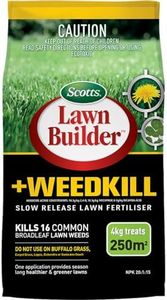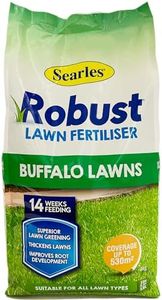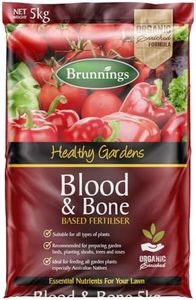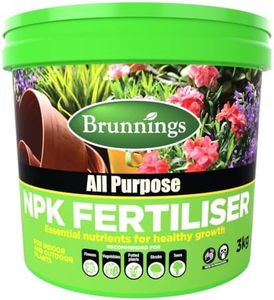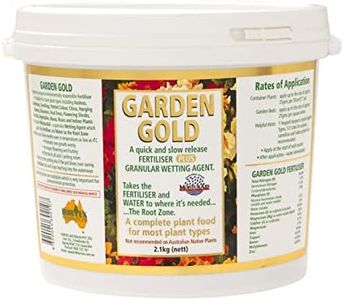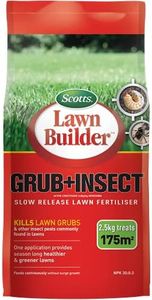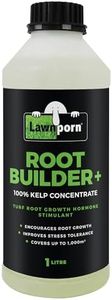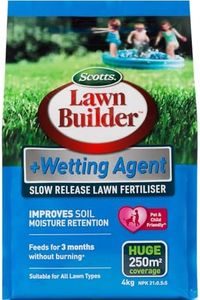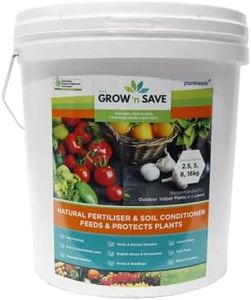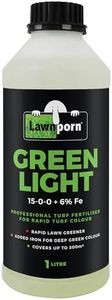We Use CookiesWe use cookies to enhance the security, performance,
functionality and for analytical and promotional activities. By continuing to browse this site you
are agreeing to our privacy policy
10 Best Lawn Fertilizers
From leading brands and best sellers available on the web.By clicking on a link to a third party's website, log data is shared with that third party.
Buying Guide for the Best Lawn Fertilizers
Choosing the right lawn fertilizer can make a big difference in the health, color, and growth of your grass. Fertilizers supplement the soil with nutrients that your lawn may not naturally get in the amounts it needs. To find the best fit for your needs, you should consider factors like the type of grass you have, the climate in your area, and the results you're hoping to achieve. By understanding the key aspects of fertilizer, you can confidently select one that matches your lawn's requirements for lush, healthy growth.N-P-K RatioThe N-P-K ratio represents the amount of Nitrogen (N), Phosphorus (P), and Potassium (K) in the fertilizer. These three nutrients are crucial for grass growth: Nitrogen promotes green color and growth, Phosphorus aids in root development, and Potassium supports overall health and stress resistance. The numbers on the package (like 10-10-10 or 30-0-4) tell you the percentage of each nutrient. Lush, green growth is aided by higher nitrogen, deeper roots need more phosphorus, and potassium is good for weather resilience and disease resistance. For established lawns, you generally want higher nitrogen and lower phosphorus. For new lawns or when repairing, a fertilizer with more phosphorus can help root establishment. Match the ratio to your grass’s needs, season, and whether your soil already lacks or has an excess of any nutrient.
Fertilizer Type (Granular vs. Liquid)Lawn fertilizers come in two main forms: granular (solid pellets) and liquid (concentrated solutions). Granular fertilizers are easy to spread and usually offer a slow, steady nutrient release, making them good for long-term feeding. Liquid fertilizers act faster and are quickly absorbed, making them useful if you want rapid results or need to correct a nutrient deficiency quickly. Choose granular if you want low-maintenance application and lasting results; choose liquid for quicker greening or if you regularly fertilize smaller lawn areas.
Release Type (Slow-Release vs. Quick-Release)Slow-release fertilizers gradually provide nutrients over a period of weeks or months, reducing the risk of burning your lawn and requiring fewer applications. Quick-release fertilizers deliver nutrients immediately, leading to faster visible growth but may require more frequent application and careful timing. If you prefer fewer applications and steady growth, slow-release is often best. If you're preparing for an event or need fast improvement in appearance, quick-release might be better, but take care not to overuse or you could damage the lawn.
Organic vs. SyntheticOrganic fertilizers are derived from natural sources like compost, manure, or plant materials, and they also help improve soil health over time. Synthetic fertilizers are chemically formulated to deliver nutrients in precise amounts for faster results. Organic types are typically gentler and improve soil in the long run, but may act more slowly. Synthetic options give rapid results and targeted feeding. If you want to minimize chemical use and support soil structure, organic can be a good choice; if you want predictable, quick changes in your lawn, synthetic may be more effective.
Application MethodFertilizer application can be done using spreaders (for granular), hose-end sprayers (for liquid), or by hand for spot-treated areas. The right method depends on your lawn size and preference. Spreaders are suitable for even coverage on larger lawns, while hose-end or handheld sprayers work well for smaller areas or quick applications. Choose a method that matches your lawn size, your comfort level with equipment, and the amount of time you want to spend applying fertilizer.
Seasonal AppropriatenessSome fertilizers are specially formulated for use in certain seasons, offering the nutrients lawns need at that time (like spring, summer, or fall blends). Spring fertilizers usually emphasize growth and green-up, while fall fertilizers focus on root strength and prepping the lawn for winter. It's important to match your fertilizer to the season to support your lawn's natural growth cycle. Pick according to the time of year and the specific needs of your grass as it grows and prepares for dormancy.

